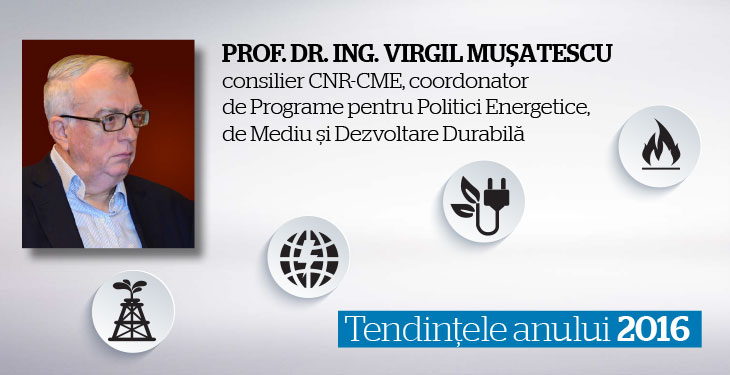Virgil Muşatescu, PHD Eng.
RNC-WEC advisor, Program Coordinator for Energy, Environment and Sustainable Development Policies
I have tried to avoid predictions regarding the price of various energy commodities, for example of heat, because that would be a very risky move. The most recent example is the different positioning on oil price which – according to the opinion of several experts – could drastically decrease (even to 16 dollars/barrel), could remain steady at around 30 dollars/barrel, or could increase by the end of the year to 60 dollars/barrel. In such a range of opinions, it is clear that one of them will be right, so one of the predictions will come true. To avoid the obvious pitfalls related to that approach, I prefer to talk about trends, qualitative aspect, not quantitative. Here are a few plausible trends that I see for 2016.
Improving the legal framework of Romania’s energy sector
Romanian lawmakers owe this to us since last year. A number of fundamental laws should be reviewed and updated: the law of electricity and natural gas, energy efficiency law, a new law on royalties for hydrocarbon concessions, combined with a holistic view regarding fees. Other legislative measures are needed to cover the obvious existing legal vacuum: a law on the development of exploration and exploitation of offshore resources and – especially – the long-awaited law for thermal energy. Their emergence will attract fundamental changes on the regulatory framework, so NAER and NAMR will have a lot of work to do.
Greater attention on energy efficiency
Not only Romania but also many other EU member states are still lagging behind with achieving energy efficiency targets. Surely, at EU level, both the European Energy Union and the results of COP 21 in Paris will boost decarbonization and reduction of energy intensity. This will give new targets at EU level, especially for 2020s but also for 2030s, which will generate new programs and projects leading to more efficient energy use. The so-called “smart” solutions will be in the forefront.
Superior integration of European electricity and gas markets
Although the deadline for internal market integration imposed by third package was in 2014, this has not happened. I think 2016 will bring a new legislative package on these markets, which will boost the process and help to achieve the target of 10% of cross-border exchanges in 2020. Obviously this will require sustained funding for some joint interconnection projects and solving coupling issues of national markets.
This year’s energy forecasts will be debated at the 2016 Spring Cocktail!
[formularEveniment]

